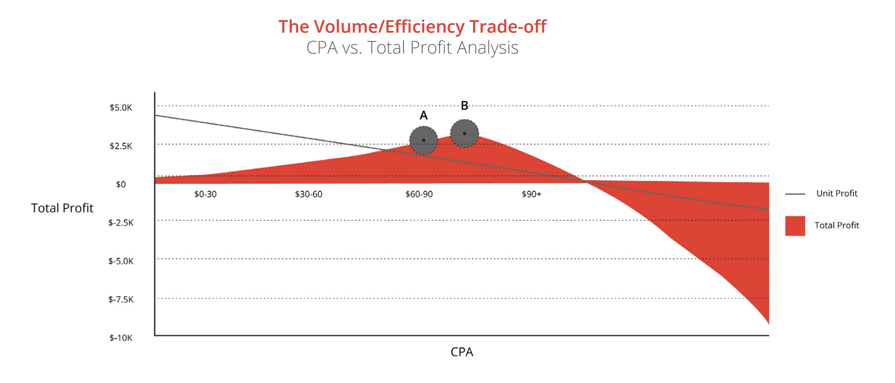Written by Krsnadasa Perez
We’ve all heard the adage: You have to spend money to make money. But, somewhere deep in our subconscious, we listen to the voice of our grandmother saying, “be smart with your money, make informed purchases and investments.”
So, what if I told you that you can listen to your Grandma and still splurge a little? Making an informed investment is easier said than done and most of the time we rely on some instinctual accounting skill, rooted somewhere in the back of our brains, without really having solid numbers. So, we stick to our traditional way of wheeling and dealing: lowering costs and boosting returns.
Profit Volume & Immediate Efficiency
The conventional marketing strategy for lowering Adwords CPAs (cost per acquisitions) and Increasing ROIs (return on investments) has been in place for quite some time now. The strategy still works for those digital marketing agencies who prefer to focus on immediate PPC (pay-per-click) efficiency instead of overall profit volume. Unlike outdated SEO tactics, the traditional marketing strategies focused on lowering CPAs are well grounded, generally speaking. But now, a new way of navigating through traditional marketing obstacles has emerged: Profit Driven Marketing.
This newly developing approach of making your company's profit the primary KPI (key performance indicator) has marketers achieving results they never thought were possible – but the truth is that often this strategy is counter intuitive. Below is an example where the CPA increases, but so did the profits.
- Efficiency is lost with the
raise in CPA between A and B - Profits increased with the increase between A and B
- Your total sales growth will end up balancing or outperforming your ROI efficiency loss
The whole philosophy revolves around being able to raise your pay-per-click
Defining Your Profits
The first step you’ll have to take is the most important one: Defining Your Profits based on the lifetime value of your customer. The more long-term profit value you can calculate based on the LTV (lifetime customer value), the more profitable opportunities you’ll be able to create. You will also be able to articulate this to your client who might be concerned over the rising CPAs or click-thru rates.
Gathering all the data to show this long-term value includes but is not limited to the following:
- Determining the lifetime value of each of your customers
- Understanding every step in their buyer journey (on and off the web)
- Word of mouth referrals
Figuring out the total profit of long-term customer relationships will be your bread and butter in the long run, not only for performance-driven marketing but also in driving branding initiatives. Imagine the benefits of being able to bid up to a customer’s lifetime value. By doing so, you’ll attract the right type of loyal customers who will bring more value to your company. Here are a few resources on calculating the following:

Summary
Before this new methodology, website conversions, lower CPAs and higher CTRs were all you needed to consider with your Google Adwords or remarketing campaign. Now it’s imperative you look at the entire purchase journey. Consumers are drowning in purchase options, and it’s up to you to be ahead of the curve and add these to your reports. You now require a bird’s eye view in this new age of marketing. Profit Driven Marketing gives us the competitive edge to connect people with what they want at the very moment they want it. Focusing strictly on traditional success markers not only leave potential profits on the table but can blur our view of the alignment of our performance goals with our business objectives.
For a better understanding of how Performance Driven Marketing can work for you, contact us today.











